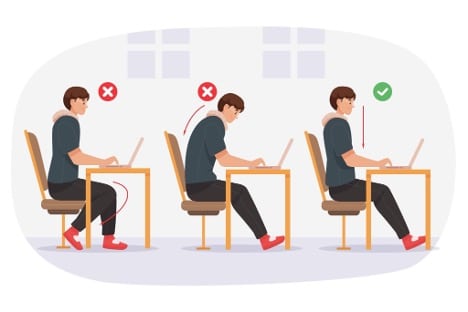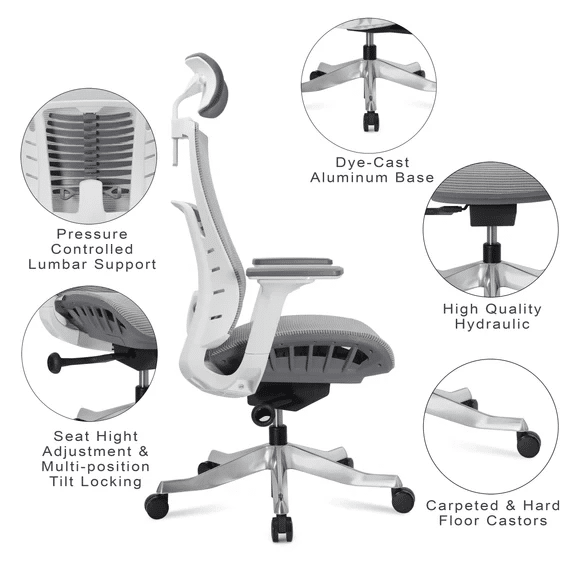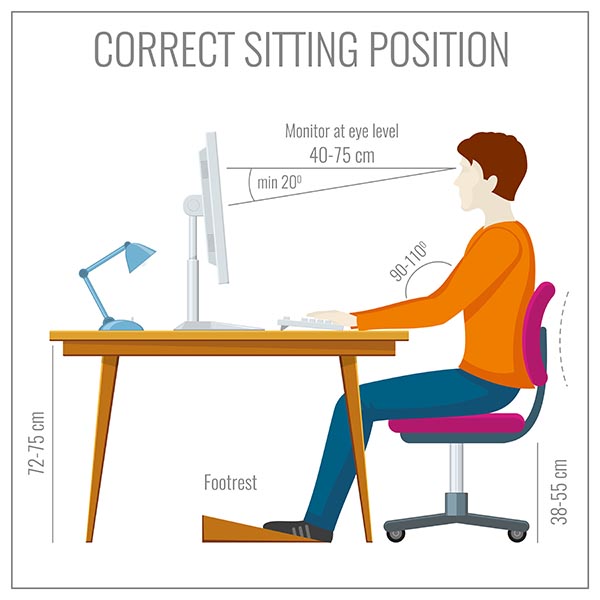In today’s fast-paced work culture, most of us spend a significant portion of the day seated, whether at desks, in meetings, or during long commutes. While sitting might seem harmless, the way we sit has a direct impact on our health, comfort, and efficiency. Poor seating choices often lead to slouched posture, back pain, and fatigue, which in turn can reduce focus and productivity. On the other hand, investing in the right seating can transform not only posture but also overall work performance. It all begins with an ergonomic office chair that supports posture and productivity.

Also Read:
- The Best Office Desk Exercises with No Equipment
- How to Relieve Back Pain while sitting at Work: Simple Exercises
The Connection Between Seating, Posture, and Health
Posture is more than just “sitting up straight.” It involves maintaining the natural alignment of the spine while keeping muscles, ligaments, and joints balanced. Proper lumbar support and ergonomic seating play a crucial role in daily back pain prevention. Incorrect seating can disrupt this alignment, causing common issues such as:
- Chronic back and neck pain from slouching or unsupported sitting.
- Muscle stiffness due to restricted movement.
- Circulation problems from prolonged pressure on the legs.
- Mental fatigue caused by physical discomfort.
Good seating supports the body’s natural curves, encourages active sitting, and reduces physical stress, laying the foundation for better health and higher productivity.
Why the Right Chair Matters
Selecting the right chair goes beyond comfort. It is a valuable investment in long-term health. A well-designed chair makes the difference. The ergonomic chair benefits include
1. Supports Natural Spinal Alignment
The structure of an ergonomic chair matches the spine’s natural “S” curve for proper alignment. Adjustable lumbar support ensures that the lower back doesn’t collapse into a slouch, reducing pressure on the spinal discs.
2. Encourages Active Sitting
Chairs with features like tilt mechanisms and seat height adjustment allow subtle movements while sitting. This “active sitting” prevents stiffness, promotes circulation, and keeps energy levels stable throughout the day.
3. Reduces Pressure Points
Quality seating distributes body weight evenly, preventing pressure on the hips and thighs. This reduces discomfort and supports longer periods of focused work without distraction.

4. Boosts Concentration
Physical comfort has a psychological effect: when you’re not distracted by pain or stiffness, your brain can focus entirely on tasks. This translates into improved concentration and higher-quality output.
5. Adaptable for Different Users
Modern workplaces often use shared seating. An ergonomic office chair with adjustable features caters to people of different body types and preferences, making it versatile for collaborative spaces without compromising ergonomics.
The Productivity Payoff
Research shows a direct link between seating and productivity, where comfort enhances focus and efficiency. Employees with ergonomic seating solutions report fewer health complaints and higher levels of efficiency. Some proven benefits of right seating posture include:
- Increased Energy Levels: Sitting comfortably reduces fatigue, enabling employees to stay engaged for longer periods.
- Fewer Sick Days: Preventing musculoskeletal issues reduces absenteeism caused by chronic pain.
- Enhanced Focus: Comfort creates mental clarity, helping workers complete tasks faster and with fewer errors.
- Positive Workplace Culture: When companies invest in ergonomic seating, employees feel valued, boosting morale and job satisfaction.
Practical Tips for Better Seating and Posture
Even the best chair won’t be effective without mindful sitting habits. Here are a few simple practices:
- Set your chair height so feet rest flat and knees form a 90-degree angle.
- Position your screen at eye level to reduce neck and shoulder strain.
- Support your lower back with proper lumbar alignment to maintain its natural curve.
- Stand, stretch, or walk briefly every 30–45 minutes to release tension and improve circulation.
- Take Short Breaks every 30–45 minutes to stretch and walk around.
- Keep your Shoulders Relaxed and your elbows close to your body when typing or using a mouse.
Watch this helpful video to learn simple ergonomic practices that improve posture and reduce discomfort at work.
Choosing the Right Ergonomic Chair: A Quick Buying Guide
Not all chairs are created equal. If you’re considering upgrading to an ergonomic chair, keep these features in mind:
- Adjustable Seat Height: Keeps feet firmly on the floor while maintaining a comfortable 90-degree knee position.
- Lumbar Support: Look for chairs with adjustable lumbar support to protect the lower back’s natural curve.
- Seat Depth & Width: The chair should allow you to sit with your back against the backrest while leaving 2–4 inches between the seat edge and the back of your knees.
- Armrests: Adjustable armrests reduce shoulder strain and help maintain proper posture while typing.
- Tilt & Recline Mechanism: A reclining backrest supports movement and relieves spinal pressure during breaks.
- Material & Breathability: Mesh or breathable fabrics prevent overheating during long hours of sitting.
- Mobility & Swivel: A swivel base with smooth-rolling casters allows easy movement without straining muscles

When evaluating options, test for comfort and adjustability. A truly supportive chair molds to your body’s needs instead of making you change your posture.
Ergonomic Seating for Work-from-Home Professionals
With remote work becoming a norm, many people are working from makeshift home setups — dining chairs, couches, or even beds. While convenient, these seating arrangements can be harmful if used daily for long hours. The best chair for home office setups combines lumbar support, compact design, and long-term comfort. Maintaining an ergonomic seating position means aligning your spine, shoulders, and legs for maximum comfort.
Here’s why home office professionals should consider an ergonomic office chair:
- Long-Term Health: Prevents back pain, neck stiffness, and repetitive strain injuries common in non-ergonomic seating.
- Professional Focus: A dedicated ergonomic chair helps separate “work mode” from “relaxation mode,” improving discipline and focus at home.
- Space-Friendly Options: Many ergonomic chairs today are compact, making them suitable even for small apartments or study corners.
- Improved Productivity: Comfortable seating reduces distractions and keeps energy levels consistent, even in home environments filled with potential interruptions.
Investing in proper seating for your home office is not just about comfort; it’s about creating a healthy, productive workspace.
Beyond Chairs: The Role of Workplace Design
While seating is central, posture-friendly work environments amplify its benefits. Effective workplace ergonomics ensures that seating, desks, and lighting align to support long-term employee well-being. Pair ergonomic chairs with height-adjustable desks, proper lighting, and organised workstations to create a holistic setup that supports both physical and mental well-being.
Frequently Asked Questions
Which is the Best Chai for Maintaining the Correct Posture at work
The best chair is one that adapts to your body. An ergonomic office chair with lumbar support, adjustable seat height, and armrests is ideal for maintaining healthy posture.
How does an ergonomic chair improve productivity?
By reducing discomfort and supporting proper posture, ergonomic chairs allow you to focus on tasks for longer without distraction. This translates into higher efficiency and better work quality.
Can I improve posture with a regular chair?
While you can use cushions or lumbar pillows to improve support on a regular chair, these are temporary fixes. For long-term benefits, an ergonomic chair is highly recommended.
What are the signs that I need a new chair?
If you frequently experience back or neck pain, numbness in the legs, or find yourself slouching constantly, your current chair may not be providing the right support.
Are ergonomic chairs worth the investment?
Yes. Considering the hours most professionals spend sitting, an ergonomic chair helps prevent health issues, boosts productivity, and enhances long-term comfort, making it a worthwhile investment.
Final Thoughts
The right seating is more than just furniture; it’s a tool for better health and productivity. By supporting proper posture, reducing strain, and creating comfort, ergonomic seating empowers individuals to perform at their best. Whether in a corporate office, home workspace, or collaborative setting, choosing seating that prioritises posture can make a measurable difference in both well-being and workplace efficiency.
Share your Review
Revise and Edit by Editorial Team
Connect with us on our Digital Endeavours-
Transforming Lives… Creating the magic. Just – Believe ~ Practice ~ Perform
BizTech Chronicle… Navigating Tomorrow’s Tech Frontiers 🚀
Youtube – Nuteq Entertainment Pvt Ltd
Trendvisionz – A Premier Digital Marketing Agency in India
Follow me on Twitter or LinkedIn. Check out our website.
✍️ A Note from the Editor
At TrendVisionz, we craft each article with purpose—guided by research, passion, and the belief that storytelling can spark change. We’ve kept our content open and free for all, because we believe knowledge should never be behind a paywall.
But creating quality digital content takes time, heart, and resources. If this article resonated with you, we’d be deeply grateful for your support. Even $10/month can help us keep producing content that informs, empowers, and uplifts.
💛 Support our work: You can contribute directly via PayPal or email us at anujmahajan@trendvisionz.com to set up your monthly support.
Thank you for believing in independent digital journalism. —Editor




1 comment
I am truly thankful to the owner of this web site who has shared this fantastic piece of writing at at this place.
Comments are closed.